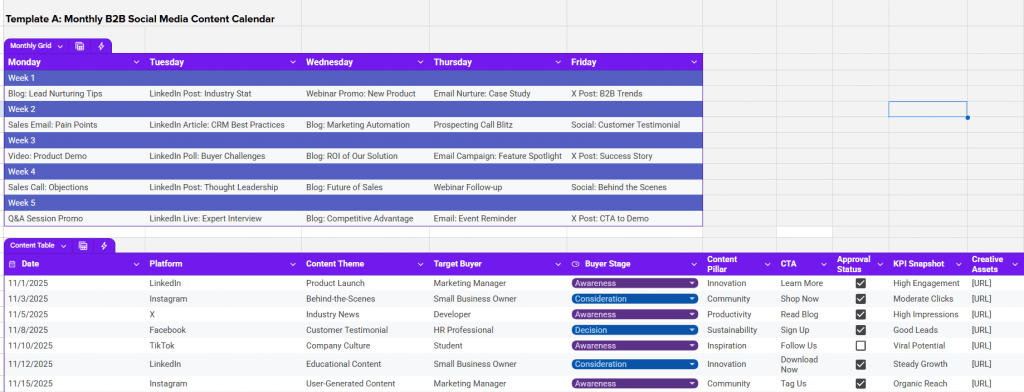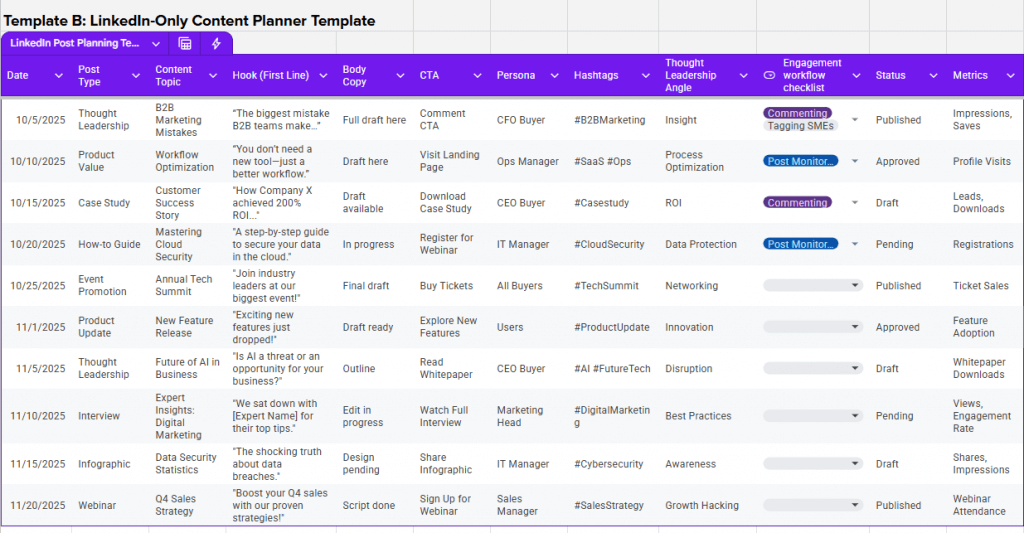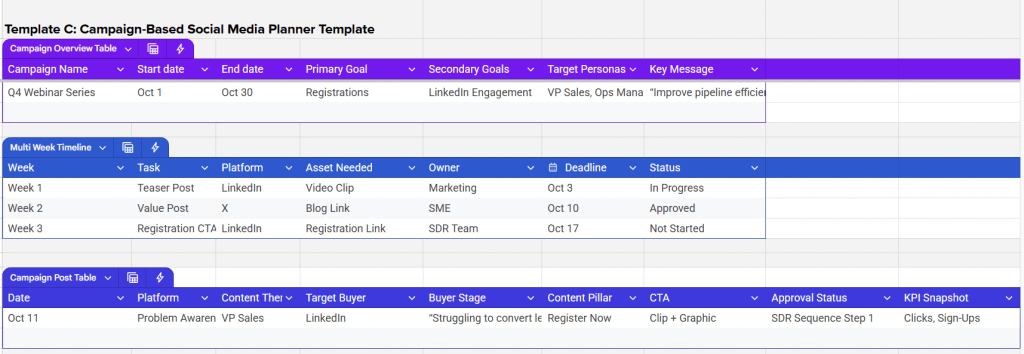-
News & Trends -
Sales -
Marketing Related Topics -
B2B Software Guides Related Topics -
Free Tools & Resources -
- About Us About Us
Social media has become one of the most reliable ways B2B companies attract leads, build trust, and shorten long sales cycles. Yet many teams still struggle with the same issues: inconsistent posting, unclear strategy, low engagement, and little alignment between marketing and sales.
To help fix that, I created a complete bundle of B2B social media planner templates, including a monthly calendar, a LinkedIn planner, a campaign template, and a weekly execution sheet. These tools give your team clarity, structure, and repeatable workflows that turn social media into a measurable growth channel.
In this guide, you’ll learn how to use these templates, build your B2B social media strategy, and create content that supports every stage of the buyer’s journey.
Social media templates are a great start, but keeping your team aligned requires a smooth system behind the scenes. If you need an easy way to collaborate on content, approvals, and weekly workflows, Google Workspace is one of the simplest tools to keep everything organized and moving. It brings Docs, Sheets, and Drive together so marketing, sales, and leadership can work in sync without slowing each other down.
I created these templates to help you simplify planning, stay consistent, and align your sales and marketing teams. Inside, you’ll find a monthly calendar, LinkedIn planner, campaign organizer, and weekly engagement workflow, which is everything you need to run social effectively.
You’ll need to make a copy of this sheet (File → Make a Copy) before you can add your own content or customize the templates. Then explore the rest of this guide to learn more about how to implement these social media planner templates.
A high-performing B2B social media planner template looks different from a typical content calendar. B2B buying cycles are longer, involve more stakeholders, and require deeper educational content. Your planner must support that complexity.
Therefore, a strong B2B-focused template should include:
1. Channel priorities
First, identify and prioritize the social media channels that align best with your business goals. For B2B professionals, platforms like LinkedIn, X (formerly Twitter), and YouTube are crucial. Also, consider joining partner communities where your target audience gathers to foster collaboration and networking.
2. Ideal customer profile (ICP) and buying committee clarity
Clearly define your ICP and the buying committee involved in the decision-making process. This understanding will help tailor your content to address each stakeholder's specific needs, challenges, and motivations, making your messaging more relevant and effective.
3. Content pillars
Develop clear content pillars that reflect your brand’s objectives and resonate with your audience. These pillars should guide the types of content you create, whether it be educational articles, case studies, infographics, or video content, ensuring consistency in your messaging while addressing varied aspects of your industry.
4. Posting cadence and scheduling workflows
Create a posting schedule that specifies how often you'll post across platforms. Think about the best times for engagement based on your audience's habits. Using scheduling workflows can also help make the content creation and distribution smoother and ensure posts are timely and well-organized.
5. KPI tracking
Implement a framework to track the key performance indicators (KPIs) most important to your B2B social media strategy. Regularly monitor metrics such as click-through rate (CTR), qualified leads generated, and meetings booked. Setting benchmarks for these KPIs will also help you evaluate effectiveness and refine your strategies as needed.
Looking to turn your improved social media planning into measurable results? Explore our complete guide on inbound lead generation to learn how to attract, capture, and convert high-quality B2B leads: Online Lead Generation: How to Generate Inbound Leads.
By integrating these elements into your social media planner template, you can create a more strategic and effective approach that drives engagement, nurtures leads, and ultimately contributes to your business growth.
Below is an overview of the four templates included in the Selling Signals bundle. Each template covers a different layer of planning and execution while ensuring your content aligns with B2B buyer needs and revenue goals.
Although I used Google Sheets to organize the templates, you can use any spreadsheet or project-planning software to map your social media content.
| Template | Purpose | Format | Best for |
| A. Monthly B2B Social Media Content Calendar | High-level planning across multiple channels | • Google Sheets or tables • Excel • Notion table view | • Marketing teams • Content strategists • CMOs |
| B. LinkedIn-Only Content Planner Template | Planning and optimizing thought leadership and marketing posts | • Google Sheets • Notion gallery view | • Founders/ executives, • Marketing teams • Sales-led posting |
| C. Campaign-Based Social Media Planner Template | Align social media with larger marketing campaigns | • Spreadsheet • Campaign workflow timeline | • Marketing leaders • Product teams • Revenue operations |
| D. Weekly Execution & Engagement Workflow | Support daily posting, monitoring & commenting | • Kanban board • Spreadsheet | • Social managers, • SDRs • Marketing team members |
This template offers a monthly, high-level view of your social media activity. It’s best for teams that need a clear roadmap for multichannel planning, approvals, and consistent messaging throughout the month.
It also helps unify content themes, coordinate publishing dates, and keep everyone aligned during reviews and planning cycles.
Specifically, the templates include a calendar grid and a content table. These work together, so you can choose dates on the calendar, then fill in the supporting details in the table.

Some additional sections included in the content calendar are:
This template is designed specifically for planning and optimizing LinkedIn posts and is best for executives, sales reps, and marketers who rely on LinkedIn for thought leadership, visibility, and engagement. It helps teams craft stronger hooks, align posts to personas, and stay consistent with daily engagement routines.
Specifically, this planner includes fields for writing, optimizing, and tracking individual LinkedIn posts without a focus on weekly or monthly timelines. However, you can combine this planner with any of the other templates for more date-specific visibility.

Specifically, this template contains:
This template organizes content around major B2B campaigns and is best for managing webinars, launches, events, gated assets, and multi-week promotions. It ensures messaging stays aligned across channels while helping teams track deliverables, deadlines, and cross-functional responsibilities.

Key features include:
This template provides a daily structure for your social execution and is best for teams that need a dependable weekly rhythm for posting, engaging, and supporting content across marketing and sales.
You can also automate these workflows in Google Sheets or your software of choice to keep daily activities organized and to send notifications to team members for greater transparency and accountability.

What it includes:
Now that you understand the templates, creating a successful B2B social media strategy also involves a clear implementation process. The steps below walk you through building a structured, repeatable plan using the templates in your bundle.
Together, they make sure your content is intentional, measurable, and tailored to support every stage of the B2B buying journey.
A strong B2B social media plan begins with clear, measurable goals aligned with your overall marketing and revenue targets. Instead of chasing vanity metrics like impressions or follower count, focus on outcomes that truly matter, such as driving qualified traffic, generating leads for your sales team, building thought leadership, or increasing event or webinar sign-ups.
Use the Monthly Content Calendar to link each planned post to a specific goal category. This allows teams to visually verify that their content mix supports the right objectives and helps avoid overly promotional or unfocused monthly campaign planning.
B2B buying decisions rarely come from one individual. Your plan should reflect the perspectives of multiple stakeholders: economic buyers, technical evaluators, end users, and internal champions. Take time to document your ICP and each persona’s role and information needs.
Each template in your bundle includes fields for target buyer or persona alignment. Consistently updating these helps your team produce content tailored to the real people involved in the buying process, rather than a generic audience. This ensures your messaging resonates with each stakeholder at each stage of the funnel.
Want a deeper walkthrough on defining your ideal customer and key personas? Check out our guide: How to Create a Customer Profile in 7 Steps (+ Free Template).
Choosing the right social platforms is crucial for B2B success, and it’s rarely a one-size-fits-all choice. While LinkedIn is generally the most impactful channel for B2B teams, supporting platforms like X (Twitter), YouTube, or industry-specific communities can also be valuable.
Your LinkedIn Planner helps you create high-quality posts that target your personas and buying stages. Use this template to plan your posts’ hooks, value propositions, and engagement strategies.
If LinkedIn is your main channel, this template becomes your weekly and daily guide for building visibility and authority. At the same time, the Monthly B2B planner is great for monitoring a variety of social media platforms.
Content pillars keep your messaging focused, repeatable, and aligned with your buyers’ needs. Most B2B teams find success using 3–5 pillars, such as industry insights, product education, customer stories, thought leadership, or event promotion.
With the Monthly Planner, you can categorize each piece of content by its theme or pillar to ensure that your month is balanced and strategically aligned. The LinkedIn Planner then helps you customize the format and structure, whether you’re posting a text update, a carousel, a video, or a thought leadership piece. This combination ensures both high-level alignment and platform-specific optimization.
Looking to refine your content formats and strengthen your platform-specific approach? Explore our guide: LinkedIn Lead Generation: Strategies, Steps & Expert Tips.
Major campaigns, such as webinars, whitepapers, product updates, or live events, require coordinated content spanning multiple weeks. Use your Campaign Planner to map out pre-launch teasers, mid-campaign value posts, and hard CTA posts leading up to key conversion moments.
The campaign template also includes fields for sales enablement support, so your team members can share aligned content during outreach. This keeps marketing and sales on the same page, ensuring every touchpoint reinforces your campaign goals.
Consistency fuels B2B social success. Even the most effective strategy fails without a repeatable posting and engagement routine, especially since a Buffer study found that accounts posting consistently over 20+ weeks earned 5× more engagement per post than those posting sporadically.
This is why your Weekly Workflow template outlines daily posting tasks, engagement duties, and cross-team actions, ensuring content not only goes live but is also backed up.
Use this workflow to assign who posts, comments, monitors replies, and engages with ICP accounts each day. This structure enhances reach, builds credibility, and maintains an active presence without causing chaos, confusion, or burnout.
Use the KPI sections in your templates to measure what’s working and adapt accordingly. Track metrics such as:
These insights reveal what to amplify, adjust, and retire.
Evaluate and adjust your monthly calendars every 30 days, using performance trends to guide the next cycle of content and campaigns.
Before implementing your finalized strategy, it's helpful to base your approach on proven best practices. These guidelines ensure your content remains consistent, aligned with business goals, and tailored to how B2B buyers actually make decisions.
The following principles will help you maximize the impact of your templates, strengthen cross-team alignment, and keep your social presence both strategic and practical.
Blend corporate content with team-led content
To build genuine connections, balance your polished corporate messaging with content created by your organization's people. Employees bring authenticity that branded channels alone can’t replicate, and the data backs it up.
According to Clearview Social, employee advocacy can boost brand reach by up to 561% and generate 800% more engagement than posts shared by a company profile. They also report that 30% of a company’s LinkedIn engagement comes directly from employee-generated content, demonstrating the influence of team voices.
With that in mind, share perspectives from different departments, highlight employee achievements, and showcase real customer stories. This strategy humanizes your brand and positions your team members as trusted thought leaders — not just corporate representatives.
Use data from templates to guide experiments
Your templates monitor key performance metrics, such as format, hook, theme, and posting time. Use that data to identify patterns and run low-risk experiments.
Test new content types, adjust your posting schedule, or try fresh approaches to see what generates better engagement. Small, controlled tests help refine your strategy and ensure you’re improving month over month.
Make social media cross-functional
B2B social performs best when marketing collaborates with other teams. Involve sales, customer success, product, and leadership to create content that reflects the complete customer experience.
According to Gartner, organizations where marketing and sales share buyer-journey insights are 2.3× more likely to achieve higher conversion rates, underscoring the value of cross-functional alignment.
Regular teamwork helps keep messaging consistent across all touchpoints and supports the honest conversations happening throughout the sales cycle.
Align posting with revenue-driving initiatives
Your social content should showcase key moments: product launches, webinars, campaigns, customer stories, and event promotions. Coordinate posts with your revenue calendar so each initiative gains the visibility it needs.
If you want more actionable insights, you’ll love our weekly tips and resources. Subscribe to the Selling Signals newsletter to stay ahead of what’s working in B2B.
When your social strategy directly aligns with business priorities, it becomes easier to identify what affects results and where to focus efforts to improve. Setting clear objectives and tracking how your social media activities impact revenue can also offer insights into areas for growth and better alignment with business goals and priorities.
Creating a social media planner template helps centralize all your ideas, schedules, and workflows, ensuring your team posts regularly, stays aligned with marketing goals, and maintains a cohesive brand voice across channels.
Yes. A shared template gives both teams visibility into upcoming content, enabling coordinated outreach, unified messaging, and stronger lead-nurturing efforts.
Update your template weekly or monthly to reflect new content ideas, campaign priorities, performance insights, and shifts in audience behavior.
Having a diverse range of social media planner templates is highly beneficial for B2B teams. These tools help maintain a consistent presence across platforms, support stronger brand recognition, and ensure messaging stays tightly aligned with sales and revenue goals.
Ultimately, a well-structured set of templates enhances the overall audience experience by keeping your content relevant, purposeful, and easier to act on.
By tailoring content to the needs of different stakeholders within the buying committee, they also help build stronger relationships and guide prospects through the decision-making process. To create your own social media planner, make a copy of the templates below.

Selling Signals delivers actionable advice for sales and marketing professionals. Learn strategies that help you hit targets, strengthen customer relationships, and win more business. Get expert advice on lead generation, sales processes, CRM software, sales management, and account management directly to your inbox.
Property of TechnologyAdvice. © 2025 TechnologyAdvice. All Rights Reserved
Advertiser Disclosure: Some of the products that appear on this site are from companies from which TechnologyAdvice receives compensation. This compensation may impact how and where products appear on this site including, for example, the order in which they appear. TechnologyAdvice does not include all companies or all types of products available in the marketplace.